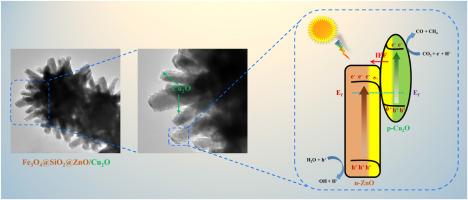0D p型Cu2O与3D n型Fe3O4@SiO2@ZnO的s型异质结高效促进CO2光还原
IF 4.6
3区 工程技术
Q2 ENGINEERING, ELECTRICAL & ELECTRONIC
引用次数: 0
摘要
s方案异质结的设计已经成为设计高性能光催化剂用于太阳能驱动的二氧化碳减排的一种引人注目的策略。本文采用分步合成的方法制备了一种新型磁性3D/0D Fe3O4@SiO2@ZnO/Cu2O (FSZC)光催化剂。通过液相还原将p型Cu2O纳米颗粒(NPs)组装到n型ZnO纳米棒(NRs)上,成功构建了s型异质结。在SEM和TEM图像中可以清楚地观察到Cu2O纳米颗粒与ZnO纳米颗粒之间的界面键合。p-n异质结的内置电场和S-scheme电子转移机制的协同作用显著促进了光生电荷的分离和迁移,从而大大优化了材料的CO2光还原活性。紫外可见照射4 h后,FSZC6的CO和CH4的产率分别为203.12 μmol/g和7.12 μmol/g,分别是FSZ的4.14倍和8.79倍。系统地阐明了CO2光还原增强机理。实验结果表明,这种新型磁性s型异质结光催化剂具有高效率、可回收性和稳定性。本文章由计算机程序翻译,如有差异,请以英文原文为准。

S-scheme heterojunction of 0D p-type Cu2O and 3D n-type Fe3O4@SiO2@ZnO for efficiently boosting CO2 photoreduction
The design of S-scheme heterojunctions has emerged as a compelling strategy to engineer high-performance photocatalysts for solar-driven CO2 reduction. In this paper, a novel magnetic 3D/0D Fe3O4@SiO2@ZnO/Cu2O (FSZC) photocatalyst was developed through a stepwise synthesis strategy. An S-scheme heterojunction was successfully constructed by assembling p-type Cu2O nanoparticles (NPs) onto n-type ZnO nanorods (NRs) through the liquid-phase reduction. The robust interfacial bonding between Cu2O NPs and ZnO NRs can be clearly observed in both SEM and TEM images. The synergistic effect of the p-n heterojunction's built-in electric field and the S-scheme electron transfer mechanism significantly boosts photogenerated charge separation and migration, thereby substantially optimizing the material's CO2 photoreduction activity. After 4 h of UV–vis illumination, FSZC6 yielded 203.12 μmol/g CO and 7.12 μmol/g CH4, representing 4.14-fold and 8.79-fold enhancements over FSZ, respectively. The enhancement mechanism for CO2 photoreduction was systematically illuminated. The experimental results demonstrate that this novel magnetic S-scheme heterojunction photocatalyst exhibits high efficiency, recyclability, and stability.
求助全文
通过发布文献求助,成功后即可免费获取论文全文。
去求助
来源期刊

Materials Science in Semiconductor Processing
工程技术-材料科学:综合
CiteScore
8.00
自引率
4.90%
发文量
780
审稿时长
42 days
期刊介绍:
Materials Science in Semiconductor Processing provides a unique forum for the discussion of novel processing, applications and theoretical studies of functional materials and devices for (opto)electronics, sensors, detectors, biotechnology and green energy.
Each issue will aim to provide a snapshot of current insights, new achievements, breakthroughs and future trends in such diverse fields as microelectronics, energy conversion and storage, communications, biotechnology, (photo)catalysis, nano- and thin-film technology, hybrid and composite materials, chemical processing, vapor-phase deposition, device fabrication, and modelling, which are the backbone of advanced semiconductor processing and applications.
Coverage will include: advanced lithography for submicron devices; etching and related topics; ion implantation; damage evolution and related issues; plasma and thermal CVD; rapid thermal processing; advanced metallization and interconnect schemes; thin dielectric layers, oxidation; sol-gel processing; chemical bath and (electro)chemical deposition; compound semiconductor processing; new non-oxide materials and their applications; (macro)molecular and hybrid materials; molecular dynamics, ab-initio methods, Monte Carlo, etc.; new materials and processes for discrete and integrated circuits; magnetic materials and spintronics; heterostructures and quantum devices; engineering of the electrical and optical properties of semiconductors; crystal growth mechanisms; reliability, defect density, intrinsic impurities and defects.
 求助内容:
求助内容: 应助结果提醒方式:
应助结果提醒方式:


